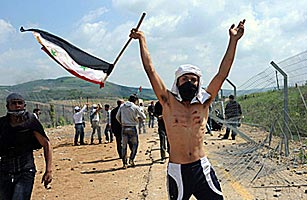
When Syrian tanks and soldiers poured into the rebellious southern flashpoint city of Dara’a last month, the Twittersphere lit up with wry comments like “Hey army, that’s Dara’a, not the Golan!” mocking the fact that the same army shooting its own people hadn’t fired a bullet in decades to liberate the Golan Heights, captured by Israel in the 1967 war and still the center of the long-simmering conflict between Israel and Syria. In fact, Damascus has long worked hard to ensure the strategic plateau remained one of the quietest border areas in the Middle East, branding the area a military zone and maintaining tight control.
But on Sunday, the Golan was anything but quiet.
For the first time in decades, there was violence on the Syrian-Israeli border. This year, protesters did more than just mournfully mark the annual anniversary of the Palestinian Nakba, or catastrophe, an event that recalls the 1948 creation of the Jewish state and the displacement of Palestinians. Instead, thousands of Syrian and Palestinian protesters attempted to barrel through the frontier fence into the Druze village of Majdel Shams, and hundreds reportedly succeeded; the unprecedented incursion met with an Israeli military response that left four Arabs dead, according to Al-Jazeera, and dozens wounded, although the official Syrian news agency SANA put the fatalities at two and said 170 people were wounded. There was also bloodshed along some of Israel’s other borders on Sunday, most notably in south Lebanon, where some 10 protesters were killed, and in the Palestinian territories, where one person was killed.
The day’s deadly events and uncharacteristic civilian push on several of Israel’s borders raised questions about its origins. Was it the result of a new sense of Arab empowerment, after the toppling of dictators in Tunisia and Egypt, and challenges to several others, including Syria’s President Bashar al-Assad? Or were Sunday’s events a calculated diversion by a regime in Damascus that has so far failed to subdue a two-month-long uprising, and perhaps felt the need to remind its citizenry of its “resistance” credentials, with a little help from its friends?
The answer is that the two may not be mutually exclusive.
Damascus has long declared itself the beating heart of pan-Arab nationalism, a lynchpin state in an anti-American, anti-Israeli “resistance axis” that includes the Lebanese militant group Hizballah, the Palestinian Hamas movement, and Iran. It’s hard to imagine how the Golan incursion from the tightly-controlled Syrian side could have happened without official permission of some sort. The same goes for the stone-throwing incidents in Lebanon . Members of the Palestinian groups Hamas and Fatah, newly reconciled after a bitter years-long dispute, were also proudly involved.
“This is the diversion the Assad regime wanted so badly,” said Emile Hokayem, senior fellow for Regional Security at the International Institute for Strategic Studies-Middle East. “The Syrians got what they wanted; To remind people that the real fight is still against the enemy. needed to make it more vivid, he also needed to create an impression that those contesting him are traitors because they are diverting the energy and resources of the nation, at a time when it needs to confront Israel.”
Not surprisingly, Israel’s borders with Egypt and Jordan, two countries it has a peace agreement with, were quiet. The Jordanian authorities, despite the fact that some 70% or more of the population is of Palestinian origin, are adept at keeping anti-Israeli sentiment in the kingdom to a minimum. And Egypt’s post-Mubarak military leaders reportedly set up a chain of checkpoints leading to the Rafah border crossing with Gaza, turning back people who were not residents of the area.